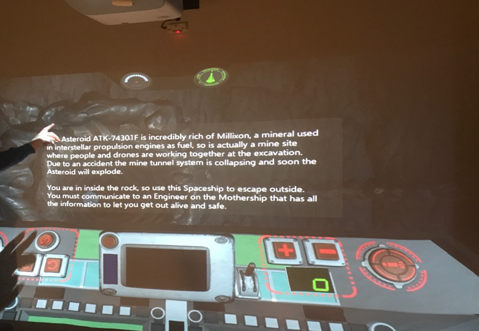Speed, creativity and collaboration
Speed, creativity and collaboration! Holo-Transportation: a cooperative game developed by Logosnet and the Polytechnic School of Turin, presented by Fernando Salvetti during ICELW 2018 (Columbia University, New York). Powerful and memorable. Deep spatial navigation engaging 2 teams that have to cooperate sharing information and knowledge relevant to navigate in the right way. The teams are in different places and can’t directly look at each other: the team wearing the HoloLens has to provide the most appropriate info to the other team, taking care of the space navigation by the commands available on a big surface they are facing (part of an e-REAL interactive surface). Only in a few special situations the “drivers” are shown with images and recordings from the other team working with the HoloLens, sharing in such a way the same visual outputs.
Critical decisions
The players are asked to make critical decisions, recognize a situation requiring rapid intervention, communicate and cooperate to share relevant information and knowledge, manage unforeseen events, deciding between parallel processing or performing one task at time in a sequence–taking into consideration critical contextual factors such as a lack of time, scarcity of resources and tools, previous impacting factors.
Effective teamwork
A team that is balanced in different mental attributes has members who look at situations and communicate their ideas in different ways, leading to more varied solutions, which have been challenged and tested by those who view the situation differently. Individuals with differing behavioral preferences allow for a team to find an optimal way through cognitive collaboration to actually go about the challenge of solving issues and to communicate their solutions.
Mixed reality: HoloLens within an e-REAL lab
e-REAL is an effective setting to perform a number of tasks focusing on teamwork: learners are completely immersed in a 3D and holographic scenario where they can interact by natural gestures. The scenario integrates a wide range of challenging situations developed by visual storytelling techniques and delivered in an immersive (and interactive) way with tools tailored to provide feedback: so behavioral, cognitive and meta-cognitive aspects of performance are addressed and reviewed. e-REAL is an environment where learners have to face challenging situations that require, in order to be appropriately managed and solved, an effective teamwork aimed at facilitating complex tasks by generating repeated loops of observation, decision, action, and re-evaluation. The success factors within e-REAL are the ability to communicate, negotiate and cooperate in order to translate the knowledge of what needs to be done into effective team activity.
A self-instruction program
Holo-Transportation is a self-instruction program. After a short induction phase, users are guided through the sequence of actions required in order to perform deep spatial navigation. Mixed Reality techniques jointly with the e-REAL training environment provide more interactivity.
A qualitative evaluation with the first user panel was performed. At the end, participants were given a questionnaire asking them to rate a number of statements using a 5-point Likert scale (1: strongly disagree, 5: strongly agree). 88 users (across industry: healthcare, energy, banking, etc.) participated in the early experiments by testing the application and filling the questionnaire. All of them never (or rarely) used an AR application. Results showed a general appreciation of the system (average rate 4.4), which was found pleasant (4) and easy to use (3.7). The cognitive load required to operate the HoloLens was minimal (1.8). Voice (4.8) and gesture interaction (4.8) were evaluated positively, although some hand recognition errors reduced the feeling of having the right level of control over the system (3). Virtual contents were found engaging (4) and the reduced field of view of the HoloLens was not perceived as a severe limitation (1.3). Participants judged the system as capable of providing a real benefit as a training tool (4.8) and to help them to be more effective (4.8). Our findings show that an interactive mixed reality learning environment could be an effective training tool for enhancing team performance across industries.
Cognitive psychology and learning
What today we know about learning from cognitive psychology is that people learn by practicing, with feedback to tell them what they’re doing right and wrong and how to get better. The project’s focus is about 8 specific key performance indicators: knowledge circulation and use of available information, effective communication, setting priorities and time keeping, workload distribution, stress management within the team (mainly when a fixation’s error is occurring and detected), teamwork (mainly dealing with leadership and fellowship, power distance and cooperation). In such a way, by a teamwork activity it could be achieved a very relevant target: fostering cognitive flexibility, emotional intelligence and self-awareness, as well as honing the epistemic acumen related to reviewing ongoing processes and procedures, errors and alternative options.
Like this article? Share it!
Don’t hesitate to leave feedback in the comments section below.



